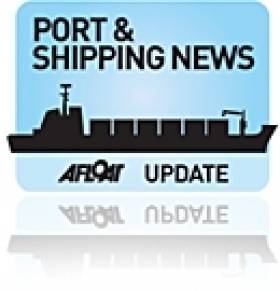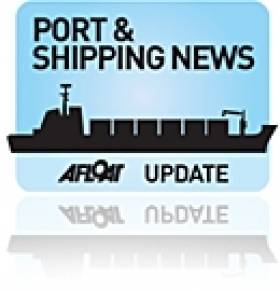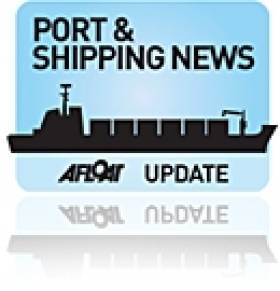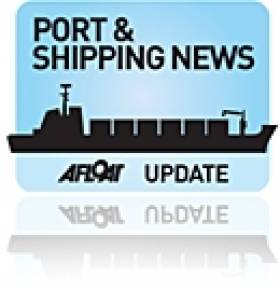Displaying items by tag: IMDO Shipping Review
IMDO Shipping Review: Irish Manufacturing Improves, Container Fleet Growth,Chemical Tanker Optimism and more
#Ports&Shipping –The latest IMDO Weekly Shipping Market Review includes the following stories as detailed below.
Irish Economy: Manufacturing improves - Irish manufacturing firms saw an improvement in overall business conditions in August as new orders grew at the fastest pace in 14 months, according toInvestec's monthly Purchasing Managers' Index (PMI). The PMI posted a 52 headline figure for August, up from 51 the months before. Anything over 50 indicates growth.
Container Market: Fleet growth continues - The size of the global containership fleet has exceeded the 17m TEU mark for the first time as carriers continue to order larger ships to cut operating costs, figures from Alphaliner showed last week. During the first seven months of the year, a total of 147 ships representing 938,500 TEU were delivered. Total deliveries are expected to exceed1.5m TEU in 2013.
Tanker Market: Chemical optimism - The chemical tanker industry is starting to turn the corner after years in the doldrums, according to Lloyd's List. The global trade in chemicals is heavily dependent on the state of the global manufacturing industry. When manufacturing slows, as has been the case in the last few year, the trade in chemicals suffers, which hits the chemical tanker segment.
For more on each of the above and other stories visit the downloadable PDF IMDO Weekly Markets Review (Week 35). In addition to Afloat.ie's dedicated Ports & Shipping News section.
IMDO Shipping Review: Manufacturing Rises, Container Carriers ‘Asset Lighters’, Panamax Grain Uplift and More
#Ports&Shipping –The latest IMDO Weekly Shipping Market Review includes the following stories as detailed below.
Irish Economy: Manufacturing prices rise in July - Irish manufacturing prices rose by 0.7% in July, although they remained 0.2% lower than a year ago. Factory gate prices –which measure the price of goods charged for by manufacturers, excluding transport costs –fell by 0.2% in the 12 months to July. The most significant price rises in July were dairy products (up 2.9%) and computer, electronic and optical products which were up 1.6%.
Container Market: Carriers are becoming 'asset lighter' - Ocean carriers are increasingly resorting to leasing/chartering to acquire vessels and container equipment, indicating the carriers are becoming significantly 'asset lighter', according to data released by Drewy. Focusing on the period from the middle of 2011 until July of this year, over 64% of all vessel capacity ordered has been placed by tramp vessel operators, and the proportion since the middle of 2012 is an even higher 65%.
Bulker Market: Grain uplift may lift Panamaxes - The Panamax segment may be about to experience a turnaround in fortunes as an uplift in exports of Soybeans and other seasonal commodities may support additional demand, according to Tradewinds. Researchers at ICAP Shipping believe there is a chance the tides could turn despite the chronic glut in global fleet capacity. In a briefing, the analysts acknowledged that US grain, soybean and soybean export volumes have hit record lows but said the trend could change this autumn.
For more on each of the above and other stories visit the downloadable PDF IMDO Weekly Markets Review (Week 34). In addition to Afloat.ie's dedicated Ports & Shipping News section.
IMDO Shipping Review: Exports Could Fall 2.8bn, Container Volumes Uplift, Dry-Cargo Demolition Drops and more…
#Ports&Shipping –The latest IMDO Weekly Shipping Market Review includes the following stories as detailed below.
Irish Economy: Exports could fall 2.8bn - The value of exports from the Republic could fall by €2.8 billion this year as earnings from pharmaceutical sales slip again, according to the latest estimates. The Irish Exporters' Association reported last week that the total value of exports in the first six months of this year was down 1.9% at €88.6 billion from €90.3 billion during the same period in 2012.
Container Market: Container volumes uplift - Volumes of containers increased at an accelerated rate in June 2013, marking the third consecutive month of growth, Container Trade Statistics [CTS] noted last week. The latest CTS aggregated volume data survey shows that, global containerized exports in June grew by 2.84% to 10.90 million TEU, which also appears to be the highest global total for June since 2011.
Bulker Market: Dry-cargo demolition plummets - Dry-cargo demolition has dropped by over 50% in 2013, according to Tradewinds. It counts 23.9million deadweight tonnes of bulkers sent to the scrap heap this year, down from 36.5 million dwt in 2012.Scr apping figures in all of the main sub-sectors are down on where they were in 2012.
For more on each of the above and other stories visit the downloadable PDF IMDO Weekly Markets Review (Week 32). In addition to Afloat.ie's dedicated Ports & Shipping News section.
IMDO Shipping Review: Weak Global Container Demand, Reduced Rotterdam Shipping and Increased German Shipping Funds
#SHIPPING -The latest Weekly Shipping Market Review from the Irish Marine Development Office (IMDO) reports of the weak global demand in container volumes in the world's top 25 ports.
The number of ships calling to Rotterdam have decreased further in 2012 where there were fewer ferry service departures, reducing the number of arrivals by 2,347 to 32,057 ship visits.
German shipping funds sold three times as many ships in 2012 as in the previous year, according to figures released by Deutsche Fonds Research (DFR). 86 vessels were disposed of last year, in comparison to only 25 in 2011.
The complete Shipping Markets Review for week 8 is available as a PDF to read or download HERE.



























































